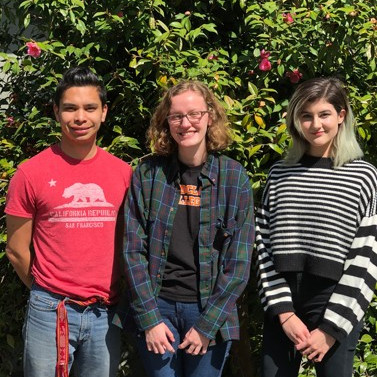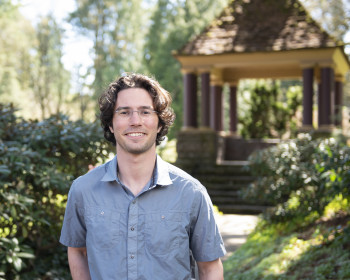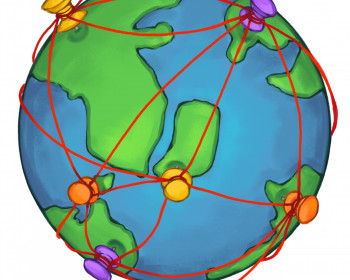Students Return from Collaborative Project to Combat Gerrymandering
Open gallery

(Ed. note: This is an update to the story below, which originally appeared in April 2018.)
by Yancee Gordon BA ’21
Adriana Rogers BA ’19, Anna Schall BA ’20, and Sherlock Ortiz BA ’20 returned to campus after a summer spent collaborating with students and professors searching for a solution to partisan gerrymandering, defined as a practice intended to establish a political advantage for a particular party or group by manipulating district boundaries. The students’ participation in the Voting Rights Data Institute utilized their interdisciplinary skills to create a mathematical solution to a problem vexing social scientists.
Ortiz, Rogers, and Schall spoke about their experiences and presented their findings at a Lewis & Clark math colloquium. Despite the progress made to prevent future gerrymandering, the students highlighted the difficulty that comes with developing quantitative methods rigorous enough to be accepted by the American judicial system as proof of partisan gerrymandering.
“My experience at the Voting Rights Data Institute was great–it was super cooperative and really valuable to work so closely with graduate students and professors,” says Rogers. “I learned how to work with many different people at once and collaborate on large-scale research projects.”
The Voting Rights Data Institute is sponsored by Metric Geometry and Gerrymandering Group, which employs professionals from Tufts University, Harvard University, and the Massachusetts Institute of Technology. This highly competitive program accepted only 35 students from across the nation, and aims to create mathematical solutions to partisan gerrymandering in time for federal redistricting in 2020.
Along with the mathematical and programming components of the experience, Ortiz also gained a greater understanding of the laws – and systemic forces – behind gerrymandering.
“My biggest issue with the gerrymandering research is that very few states are approaching organizations like the Voting Rights Data Institute because both parties want to be able to guarantee their victory,” continues Ortiz. “Gerrymandering is only really seen as a problem by people concerned with democratic institutions, so instead groups like VRDI and other activists have to create tools and resources to take to the court and challenge gerrymandering there.”
The challenge does not deter them.
“Finding research opportunities where you deeply care about the issue makes a huge difference in your motivation to keep going with the project,” concludes Rogers.“It was super motivating to see so many math and computer science focused people using their knowledge, and applying it to an issue of social importance.”
____________________________________________________________
by Yancee Gordon BA ’21
Three Lewis & Clark students—Sherlock Ortiz BA ’20, Adriana Rogers BA ’19, and Anna Schall BA ’20—have been accepted to participate in the Voting Rights Data Institute, a six-week interdisciplinary summer program sponsored by Metric Geometry and Gerrymandering Group, which employs professionals from Tufts University, Harvard University, and the Massachusetts Institute of Technology. This highly competitive program only accepts 35 students from across the nation, and aims to create mathematical solutions to partisan gerrymandering.
Students will utilize various mathematical practices to analyze recent political outcome data and create population graphs for all 50 states. The students hope to use their time in the program to analyze past political trends and biases in districts across the country, and ultimately create a solution to partisan gerrymandering in time for the 2020 federal redistricting.
“As a computer science and mathematics major at a liberal arts college, I am excited to apply the interdisciplinary skills that I have learned to important social and political issues,” says Rogers. She hopes this collaborative opportunity will contribute to a solution that has large societal impacts.
Along with campaign finance reform, which Lewis & Clark students have also recently studied, gerrymandering is especially pertinent, with the United States Supreme Court hearing cases on partisan gerrymandering this year and Justice Kennedy himself calling for a “manageable standard” to detect partisan gerrymandering.
Ortiz—who hails from Chicago—is adamant that political participation matters, and is excited to be involved with the project. “I am most excited to build algorithms that can help draw congressional district boundary lines.” He hopes his work in the program will create more representative boundaries and give a voice to all citizens.
A Pamplin Fellow and an economics and mathematics double major from Memphis, Tennessee, Schall appreciates the opportunity to combine her academic interests with helping others. “Gerrymandering is an issue I’ve been interested in since high school, and I never imagined I’d be using math to help society work toward being more fair and representative.”
“Adriana, Anna, Sherlock, and the Voting Rights Data Institute itself epitomize the kind of thinking that Lewis & Clark is all about,” says Associate Professor of Mathematics Liz Stanhope. “I see the program as a training ground for new leaders to bring together math, political science, and social justice in novel and brilliant ways.”
More Newsroom Stories
Public Relations is located in McAfee on the Undergraduate Campus.
MSC: 19
email public@lclark.edu
voice 503-768-7970
Public Relations
Lewis & Clark
615 S. Palatine Hill Road MSC 19
Portland OR 97219

